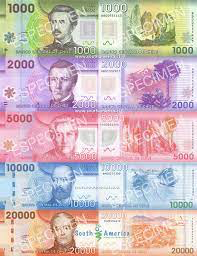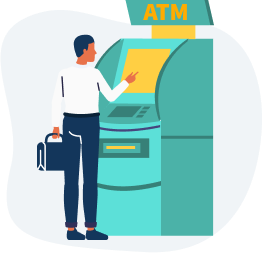Currency in Chile
The Travel Money Guide to Chile
Chile is one of our favourite jewels in South America. With so much to do like trekking the Patagonian glaciers or Cajon del Maipo, stargazing in Atacama desert, skiing down volcanos, seeing the mystical giant statues on Easter Island and visiting the old town of Santiago. But it isn’t a budget destination and to get the most out of your trip, it’s a good idea to learn everything you can about the local currency and payment options before you go.
The currency they use in Chile
In Chile, locals use Chilean Peso, which has the symbol $ and the international code CLP.
Money in Chile
Chilean banknotes have 5 denominations: $1,000 (‘Luca’), $2,000, $5,000, $10,000 and $20,000.
Coins are available in Chile but rarely used. They are 10, 50, 100 or 500 peso. When you pay in cash they will round up or down or ask if your want to give the pesos to a charity. Inflation in the 1980’s caused the demise of Chilean coins called centavos.
It’s best to carry small bills with you as it can be hard to get change for anything over $5,000 in small towns, corner shops, taxis and liquor stores.


Using Your Bank Card in Chile
Most Chilean businesses are well set up to receive card payments. Some of the best travel money cards include debit, credit and prepaid cards. But before you use your bank card willy-nilly, it’s worth reading up on the fees and charges you might incur.
Debit Cards
You’ll probably want a debit card if you plan to withdraw money from an ATM. While you may also be able to pay with a debit card in some businesses in the major destinations, you might discover some hefty fees on your account summary.
Depending on your bank, you could be hit with fees for foreign ATM withdrawals or currency conversions. But some banks are better than others; we recommend checking out Wise, ING and Revolut, all of which have travel-friendly debit cards that waive these charges.


Credit Cards
Credit cards can come with some enticing perks, including added security, loyalty programs, and even free travel insurance.
But are they worth it?
Major local businesses, including hotels, restaurants, airline offices, and department stores, accept credit cards. But you might have to pay a surcharge.
Mastercard and Visa are widely accepted. You may also be able to use your American Express card, though local ATMs won’t accept them.
Just be aware of additional charges you may incur for foreign transactions. These could include:
- International transaction fees
- High exchange rate margins
- ATM fees
- Potential ‘cash advance fees’ if you use an ATM
If you still prefer credit cards over any other payment, consider going with a company that offers cards that waive certain travel fees. Bankwest Platinum and 28 Degrees both have travel-friendly cards.
Prepaid Travel Cards
The biggest advantages of prepaid travel cards are that you can lock in a favourable exchange rate. You also get a handy back-up card.
Just remember that while they are convenient, you could end up paying a long list of hidden fees. Many travel cards still impose:
- Currency conversion fees
- Uncompetitive exchange rates
- International ATM withdrawal fees
- Initial load fees
- Reload fees
- Inactivity fees

How to Buy Chilean Peso Before You Go
There’s a certain reassurance that comes with stepping off the plane (or cruise ship) already cashed up with Chilean Peso.
Buying Chilean Peso before you leave Australian shores isn’t just convenient. It can also save you money. But it all depends on where you get your Chilean Peso in Australia. There are 3 main options:
- Buy CLP online and have it delivered or collect it in-store
- Swap Australian dollars to Chilean Pesos from a money changer
- Buy your Chile currency at your home airport
Currency exchange offices at Australian airports are notorious for their poor rates and commissions so we recommend avoiding that option entirely.
You’ll easily find a currency exchange near you; even suburban shopping centres should have at least one. But it’s better to get your money from an inner-city money exchange if possible. They have more competition, which is likely to drive their rates down.
If there’s already too much running around to do ahead of your trip, consider ordering Chilean Peso online. You can choose to have them delivered or made available for pick-up at a location near you.
Online orders are often the best value too, especially if you go with S Money, which offers the same rates listed on Google and XE.com.
How Much Cash Should I Bring to Chile?
Thanks to the surplus of ATMs and the ease of plastic payments, there’s not too much pressure on you to bring the exact amount of cash you need from the get-go.
Still, it’s a good idea to have a general daily budget to help you cost out the trip and make sure you don’t have leftover pesos at the end of your stay.
The average daily travel budget in Chile is about $200. Some of the expenses you might be looking at include:

$150 per night
A double room in a hotel

$10
A meal at a restaurant

$4
A local beer

$1.50
A one-way public transport ticket

CA$10
Entrance ticket to a show or exhibit
How to Exchange Currency in Chile
Places like Santiago and Valparaíso receive great numbers of tourists, so there are facilities to cater to money exchanges. Beyond these major destinations, it’s best to get cash before you venture into remote territory.

ATMs
We’re all used to getting our cash out at ATMs so it seems like the most convenient way to secure local cash abroad. In Chile ATM’s are known as Redblanc and have a maroon and white sticker. Its best to take a VISA or Mastercard with you to access cash through ATMs in Chile using the Cirrus or Plus networks.
Fortunately, in larger Chilean destinations including Santiago and Valparaiso, ATMs are available at banks and some post offices. But it’s worth noting that some ATMs are only accessible during the bank’s opening hours. And even when they are open 24/7, they might not necessarily offer the best value.
Depending on your bank, you may have to pay for overseas ATM withdrawals and currency conversions. To reduce the amount you’ll pay in fees, try to withdraw just the right amount of money you’ll need for the duration of your trip.
Don’t forget: Let your bank know you’re travelling! If they detect a foreign transaction but aren’t aware you’re overseas, they could end up freezing your card.
Currency Exchange in Chile
You won’t have any problem changing money in the larger cities. There are plenty of currency exchangers at the airport, shopping centres and major tourist attractions. Currency exchangers are called casa de cambios in Chile.
Licensed money changers tend to offer marginally better rates than bank. Also, banks only exchange currencies on weekdays. More Exchange and Apex have lots of stores located throughout Santiago, however Apex do not appear to swap Australian dollars, so take cash before you leave.


Travellers Cheques
Some people feel safe by taking travellers cheques to Chile. They are accepted in large hotels and a few other places in larger cities and towns.
Some people do not worth the bother taking travellers cheques with then to Chile as they are very outdated. In smaller towns you will find it hard to swap them for Chile currency.


